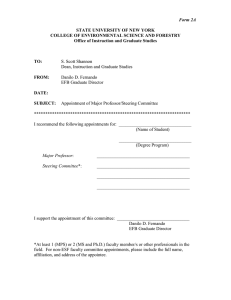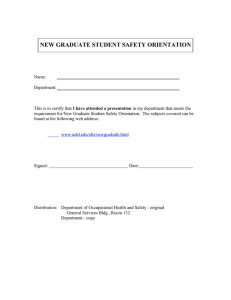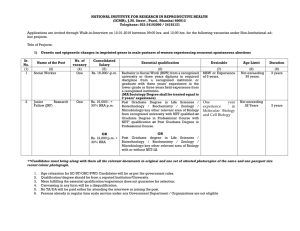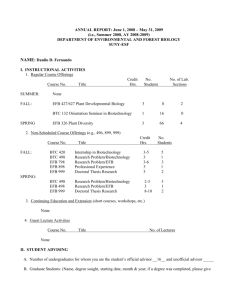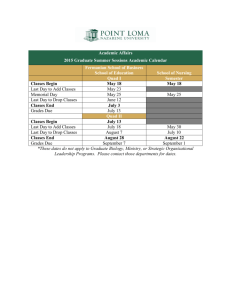ANNUAL REPORT: June 1, 2009 – May 31, 2010
advertisement
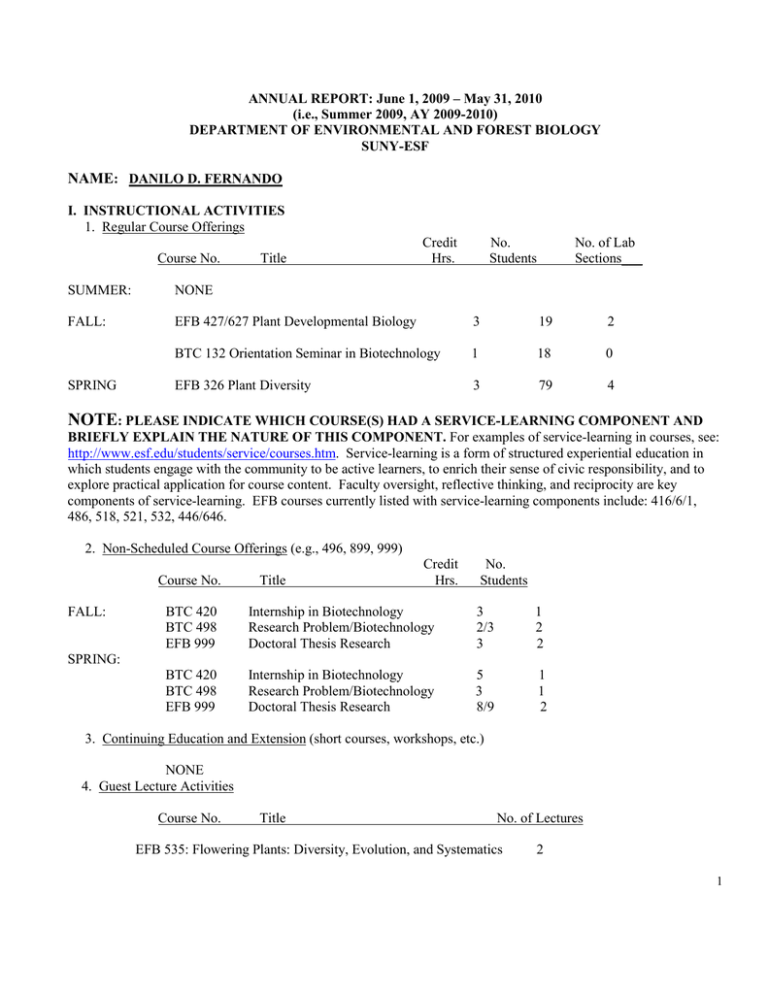
ANNUAL REPORT: June 1, 2009 – May 31, 2010 (i.e., Summer 2009, AY 2009-2010) DEPARTMENT OF ENVIRONMENTAL AND FOREST BIOLOGY SUNY-ESF NAME: DANILO D. FERNANDO I. INSTRUCTIONAL ACTIVITIES 1. Regular Course Offerings Course No. Title Credit Hrs. No. Students No. of Lab Sections___ SUMMER: NONE FALL: EFB 427/627 Plant Developmental Biology 3 19 2 BTC 132 Orientation Seminar in Biotechnology 1 18 0 EFB 326 Plant Diversity 3 79 4 SPRING NOTE: PLEASE INDICATE WHICH COURSE(S) HAD A SERVICE-LEARNING COMPONENT AND BRIEFLY EXPLAIN THE NATURE OF THIS COMPONENT. For examples of service-learning in courses, see: http://www.esf.edu/students/service/courses.htm. Service-learning is a form of structured experiential education in which students engage with the community to be active learners, to enrich their sense of civic responsibility, and to explore practical application for course content. Faculty oversight, reflective thinking, and reciprocity are key components of service-learning. EFB courses currently listed with service-learning components include: 416/6/1, 486, 518, 521, 532, 446/646. 2. Non-Scheduled Course Offerings (e.g., 496, 899, 999) Course No. FALL: Title Credit Hrs. No. Students BTC 420 BTC 498 EFB 999 Internship in Biotechnology Research Problem/Biotechnology Doctoral Thesis Research 3 2/3 3 1 2 2 BTC 420 BTC 498 EFB 999 Internship in Biotechnology Research Problem/Biotechnology Doctoral Thesis Research 5 3 8/9 1 1 2 SPRING: 3. Continuing Education and Extension (short courses, workshops, etc.) NONE 4. Guest Lecture Activities Course No. Title No. of Lectures EFB 535: Flowering Plants: Diversity, Evolution, and Systematics 2 1 BIO 340: Plant Kingdom (SUNY Oswego) 2 II. STUDENT ADVISING A. Number of undergraduates for whom you are the student’s official advisor __14__ and unofficial advisor __0__ B. Graduate Students: (Name, degree sought, starting date, month & year; if a degree was completed, please give date and full citation for the thesis or dissertation). MAJOR PROFESSOR Christina Quinn, Ph.D. Program, Started August 2006 Arnold Salazar, Ph.D. Program, Started January 2007 Maryanne Orlousky, MPS Program, Started August 2009 CO-MAJOR PROFESSOR NONE MEMBER, STEERING COMMITTEE (other than those listed above) Kathleen Baier, M.S. Program, Started August 2006 – EFB. Degree completed December 2009 Collin Fischer, Ph.D. Program, Started August 2005 – Chemistry Department (SB3 Program), SU Nikhilesh Dhar, Ph.D. Program, Started August 2006 – Biology Department, SU CHAIRMAN OR READER ON THESIS EXAMS, ETC. NONE III. RESEARCH COMPLETED OR UNDERWAY A. Departmental Research (unsupported, boot-legged; title - % time spent) Cloning and bioinformatic analysis of secreted proteins from pine pollen tubes (10%) Cloning and bioinformatic analysis of microRNAs from pine pollen tubes (10%) Development of a tissue regeneration protocol for willow (15%) Development of a pollen derived cell line from Ginkgo (5%) B. 1. Grant-supported Research (source, subject, amount - total award and current year, award period starting and ending dates; list graduate research assistants supported by each grant) Confronting the obstacles to willow genetic transformation (Tim Volk, co-PI). USDA-McIntire-Stennis, $50,591. May 15, 2010 - Sep 12, 2012. Graduate Research Assistant – Arnold Salazar (Ph.D. student) 2. Research Proposals pending (include information as in B.1., above). Genetic diversity of American hart’s-tongue fern in Clark Reservation, The Nature Conservancy, $8000 3. Research Proposals submitted, but rejected (include information as in B.1, above) 2 - Nanoparticle-mediated delivery of DNA to pollen of woody plants. SUNY-ESF, $6,000. - Genetic, reproductive and habitat analysis to support American hart’s-tongue fern reintroduction and restoration in the Great Lakes region. USDA-USFWS, $220,770. - Genomics of Pine Pollen Tube Wall Formation and Regulation. NSF. $268,574. - Genetic Improvement of loblolly pine through pollen transformation coupled with artificial pollination. ESF. $4,000. IV. PUBLICATIONS (Full bibliographic citation, i.e., do not use "with Jones," or "Jones, et al."; please list only publications published, in press, or actually submitted during this reporting period --- do not list manuscripts in preparation). A. Refereed Publications Fernando DD, Quinn CR, Brenner E, Owens JN. Male gametophyte development and evolution in gymnosperms. Invited Review. International Journal of Plant Developmental Biology (in press). Delay in publication is due to it being moved from a regular article to being part of a Special Issue. Owens JN and Fernando DD. 2009. Developmental, ultrastructural and molecular studies of male and female sterility in western white pine (Pinus monticola). In: D. Noshad, N.E. Woon, J. King and R.A. Sniezko (eds). Breeding and Genetic Resources of Five-Needle Pines. Proceedings of the Conference 2008. Yangyang, Korea, pp. 71-72. Owens JN, Kittirat T, and Fernando DD. 2009. Factors affecting seed production in Pinus monticola and P. albicaulis. In: D. Noshad, N.E. Woon, J. King and R.A. Sniezko (eds). Breeding and Genetic Resources of Five-Needle Pines. Proceedings of the Conference 2008. Yangyang, Seoul, Korea, pp. 35-44. B. Non-refereed Publications *Fernando DD. 2009. Conifer Reproductive Biology: Invited Book Review. International Forestry Review 11(4):534-535. . *Fernando DD. 2010. Conifer Reproductive Biology: Invited Book Review. Plant Science Bulletin 56(1): 3233. *Same review published in two different journals/forums C. Papers Presented at Science Meetings (give title, date, occasion, and location) Towards our understanding of pollen tube biosynthesis and evolution. Gordon Research Conference, Bryant University, Smithfield, RI. August 2-7, 2009. D. Public Service Presentations (lectures, seminars, etc. to and for the public; give group or occasion, date(s), and attendance) NONE V. PUBLIC SERVICE 3 A. Funded Service (include consulting activities) 1. Government Agencies (Federal, State, Local): NONE 2. Industrial and Commercial Groups, etc. NONE B. Unfunded Service to Governmental Agencies, Public Interest Groups, etc. Judge, Best Poster (Graduate Student), Spotlight on Student Research, SUNY-ESF, April 12, 2010. VI. PROFESSIONAL DEVELOPMENT A. Professional Honors and Awards (for teaching, research, outreach, etc.) B. 1. Activities in Professional Organizations (offices held, service as chairman, member, participant or consultant) 2. Professional Society Membership 3. Other Professional Activities a. Editorial activity Journal (s) Responsibility International Journal of Plant Developmental Biology (IJPDB) International Journal of Plant Developmental Biology (IJPDB) Member, Editorial Board Special Issue Editor Other (books, symposia, etc.) b. Reviewer Journal(s) No. of manuscripts IJPDB American Journal of Botany Scientia Horticulturae 10 1 1 Agency No. of proposals NSF (Developmental Systems Cluster) USDA 1 1 4 Consortium of Plant Biotech Research, Inc. 1 USDA McIntire Stennis 1 Other c. Participation (workshops, symposia, etc.) Name of workshop, etc. Date Place C. Further Education/Re-training Undertaken, Leaves, Workshops, etc. D. Foreign Travel (Where, When, Purpose) VII. ADMINISTRATIVE AND SERVICE RESPONSIBILITIES (include committee participation) A. Department-level Director, EFB Graduate Program Member, Graduate Program Advisory Committee Coordinator, Committee on Optical Instruments and Equipment B. College-level Member, Graduate Council C. University-wide, including Research Foundation NONE VIII. SUMMARY OF SIGNIFICANT ACTIVITIES AND ACCOMPLISHMENTS DURING THIS REPORTING PERIOD, ESPECIALLY THOSE MOST NOTEWORTHY AND RELATIVE TO THE COLLEGE’S AND DEPARTMENT’S MISSION. One paragraph on each of the following would be most helpful: this past year, what have you done for our students, department/college, and self professionally? NOTE: The information in this section (along with the supporting specific information elsewhere in this report) should be your strongest case for being considered for a discretionary raise, which I’ll continue to award based on your contributions to the department and college this reporting period. For the Students: This past academic year, I taught Plant Developmental Biology and Plant Diversity, convened the freshman orientation seminar for biotechnology majors, trained several undergraduate students in my lab through independent research and internship, presented invited lectures to two different courses, and worked with my two Ph.D. students on various aspects of their research and grant/fellowship applications. In total, at least 123 students have been served in various capacities. To enhance student interest in my classes and broaden their understanding of various groups of plants, I invited several speakers to give presentations in Plant Diversity, such as Drs. Robin Kimmerer and Martin Dovciak (who talked about bryophytes and overview of flowering plants, respectively) and Dr. Jim Seago (from SUNY Oswego) who talked on Basal Angiosperms and root development in wetland plants. 5 For the department/college: I served as the Director of our graduate program (for the third year) and my major responsibilities included the following: 1) replied to various inquiries about our graduate program (through email, phone, and/or personal visits) on an almost daily basis from several potential applicants and current graduate students, 2) processed a total of 129 applications (22 for spring and 107 for fall) that involved reviewing each application for initial assessment and to designate specific reviewers, following up on the completion of the reviews on each application, summarizing the reviews for each application, and submitting EFB’s recommendation for each accepted and rejected applications to the Dean of Instructions and Graduate Studies, and 3) provided orientation seminars to new graduate students about our graduate program. I also served as the department’s representative to the Graduate Council and raised issues regarding problems/suggestions on how to improve the graduate program. I have also shared the ideas and activities of OIGS to the department’s graduate committee and faculty. As the coordinator on optical instruments in the department, I worked with Bridget McMaster regarding various problems on light microscopes and teaching needs. For my professional accomplishments, the following are what I consider as significant: 1) served as a Guest Editor for a Special Issue on Plant Development and Evolution by the International Journal of Plant Developmental Biology. I have received and reviewed all 10 invited reviews from various colleagues around the world, invited and formed at least three reviewers for each of the manuscripts, reviewed and synthesized the reviewers’ comments for each of the manuscripts. I also made sure that most of the reviewers’ comments were addressed in the revised manuscripts. This Special Issue will be published in July 2010; 2) served in the USDA Plant Biology: Growth and Development panel to review grant applications in Washington DC in September 2009. I reviewed 16 grant proposals (as primary, secondary or tertiary reviewer) and participated in the deliberations of at least 75 proposals; and 3) following proposal review, integration of reviewers’ comments/suggestions and various other negotiations, the publisher - Taylor and Francis Group has unofficially approved our proposal (with my co-author - Dr. John N. Owens) to write a textbook on “Sexual Reproduction of Trees.” The start date of this 15-month activity is still under negotiation. IX. A. FUTURE PLANS, AMBITIONS, AND POTENTIAL CONTRIBUTIONS FOR YOUR OWN PROFESSIONAL DEVELOPMENT AND THE ENHANCEMENT OF THE PROGRAM IN ENVIRONMENTAL AND FOREST BIOLOGY (brief summary) For the next academic year, the bulk of my time will be spent in the following activities: 1) teaching, 2) research, 3) graduate admissions, and 4) textbook writing. B. PROJECTED ACTIVITIES FOR NEXT YEAR 1. Summer 2010 a. Course(s) to be offered b. Proposed research activity c. University, professional society, and public service 2. Fall Semester 2010 a. Course(s) to be offered 6 EFB 427/627: Plant Developmental Biology BTC 132: Orientation Seminar for Biotechnology Majors b. Proposed research activity In vitro regeneration of willow Genetic diversity of American harts-tongue fern Write grant applications, particularly on use of molecular markers to refine willow selection Mechanism of pine pollen germination (roles of microRNAs and secretory proteins) c. University, Professional society, and public service Review of graduate applications, participate in the activities of GPAC and Graduate Council. 3. Spring Semester 2010 a. Course(s) to be offered EFB 326: Plant Diversity b. Proposed research activity In vitro regeneration of willow Mechanism of pine pollen germination (roles of microRNAs and secretory proteins) Write grant applications c. University, professional society, and public service Review of graduate applications and participate in the activities of GPAC and Graduate Council. 7
